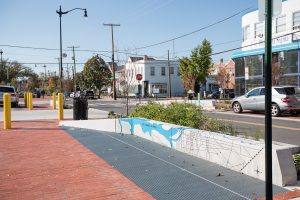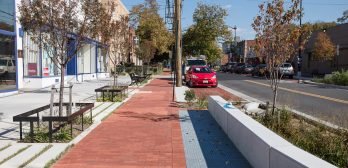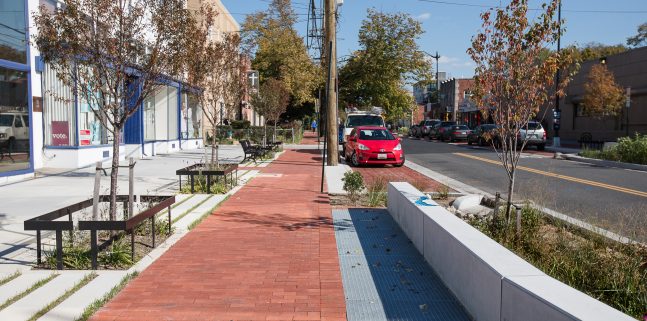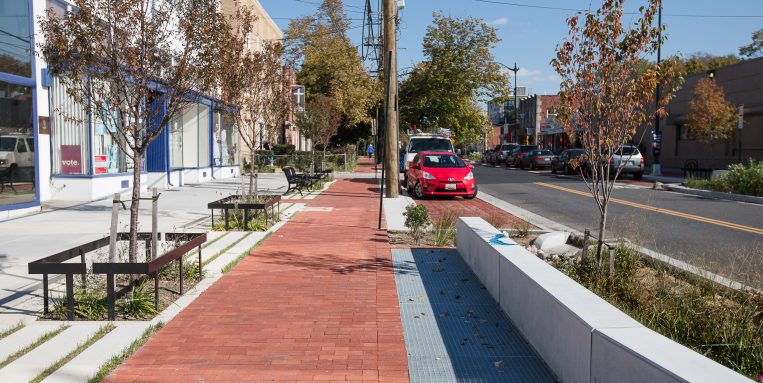Nitsch Engineering designed a high-performance urban streetscape retrofit that serves as a model to help reduce the District’s combined sewer overflow discharges
The District of Columbia Water and Sewer Authority (DC Water) Kennedy Street Green Infrastructure Challenge project won a 2019 Engineering Excellence Honor Award from the American Council of Engineering Companies of Metropolitan Washington (ACEC/MW) on January 23, 2019. The award recognized Nitsch Engineering for their unique approach to stormwater management on the city block, which included 33 interconnected Green Infrastructure (GI) Best Management Practices (BMPs) that are designed so that one facility can overflow into the next, creating a long, slow path for stormwater to travel.
As part of their efforts to use GI techniques to address Combined Sewer Overflows (CSOs) in the District, DC Water launched an international design competition in April 2013 with the goal of finding innovative ways to capture water before it could enter the combined sewer system, thereby reducing the need to construct additional storage tunnels. The Nitsch Team was selected to design, permit, and construct the streetscape retrofit project, which serves as a model for future GI improvements throughout the District.
 The Nitsch Team’s design provides environmental, social, and economic benefits to Kennedy Street by incorporating increased landscaping into the streetscape that collects and infiltrates stormwater, as well as enhancing walkability and improving the pedestrian experience. By installing (and connecting) five technologies – bioretention curb extensions, landscape infiltration gaps (a European technique that had not been used in a U.S. public space before this), recessed landscape planters, permeable paver areas, and dry wells – in 33 locations on the block, the overall GI system design results in the reduction of 9,000 square feet of impervious surface, and the retention of 59,941 gallons of stormwater. The design retains all of the stormwater from the 2.1” rainfall event for the 1.14-acre site – exceeding the initial goal of retaining the 1.2” rainfall event.
The Nitsch Team’s design provides environmental, social, and economic benefits to Kennedy Street by incorporating increased landscaping into the streetscape that collects and infiltrates stormwater, as well as enhancing walkability and improving the pedestrian experience. By installing (and connecting) five technologies – bioretention curb extensions, landscape infiltration gaps (a European technique that had not been used in a U.S. public space before this), recessed landscape planters, permeable paver areas, and dry wells – in 33 locations on the block, the overall GI system design results in the reduction of 9,000 square feet of impervious surface, and the retention of 59,941 gallons of stormwater. The design retains all of the stormwater from the 2.1” rainfall event for the 1.14-acre site – exceeding the initial goal of retaining the 1.2” rainfall event.
Although the project was conceived as part of a larger strategy to use GI techniques to address CSOs, it became much more than a stormwater management project. The bioretention curb extensions narrowed the roadway, resulting in slower traffic and shortened crosswalks that make Kennedy Street safer for pedestrians. Seat walls with engraved art, new street furniture, and 35 additional street trees further improve the pedestrian experience.
Due to the innovative nature of the project, as well as its location within a public right-of-way, the Nitsch Team – which included landscape architects Urban Rain|Design and Warner Larson, land surveyor and geotechnical engineer EBA Engineering, and community engagement specialist Tina Boyd and Associates – guided the project through a complex permitting process required by the District Department of Transportation (DDOT), the District Department of the Environment (DDOE), and various other permitting authorities. We also led a thorough public education and outreach effort, developing project graphics and educational tools for use at two facilitated public meetings during the schematic design phase.



